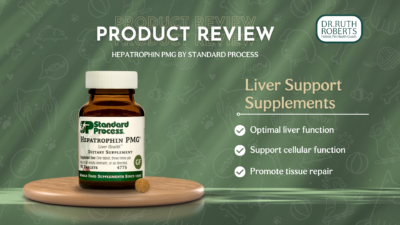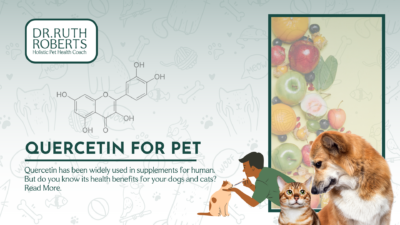What vaccines does your pet really need? And which ones do more harm than good? Dr Ruth talks about which pet vaccines truly help, and what to avoid.
So, today, I want to talk with you, actually all this month what I want to talk with you about is preventive medicine. So, today and next week I’m going to talk to you about what most veterinarians consider to be preventive medicine, and then we’ll get into some actual preventive medicine.
Hello, I’m Dr. Ruth Roberts, your pet’s ally and Happy New Year again if you didn’t make it last week I am in Roatan, Honduras so I will apologize in advance if the internet bombs out on us but hopefully it will work really well.
So, today I’m going to be talking to you about vaccinations, and it’s a really thorny topic. So, while I’m talking with you a little bit, I’m going to put a little poll up that asks you how often you vaccinate your pet, and just answer as you see fit. Tell me what you think. And so some of those questions are a little bit of a setup, but they discuss things that I want you to think about.
So, as far as vaccinations go, as I said, there’s a lot of hype around them, both for humans and for pets. And so, we’ve gone from believing that vaccines are causing autism, and there’s evidence that there is some possible link to it, as far as the mercury that’s in the vaccines. But more likely, it seems to be related to things that moms are doing while they’re pregnant, which is very interesting. And there are many veterinarians out there that say that vaccines are evil incarnate and they are responsible for destroying your pet’s health. There is some truth to that, but it’s not the whole truth.
So, let me go over a couple of things while you’re taking a look at that poll, and hopefully it’s showing up there for you guys to kind of pick. So, vaccinations are based on the idea of herd health. And what that means is, that if most, some percentage of the population is protected, then the entire population is protected from a massive epidemic. And so, to give you an example of what that might be, rabies vaccination. So, we still see rabies in dogs and cats, and in people for that matter. There was a woman reported last week that died after she went to a yoga retreat in India, and petted a little puppy and the puppy bit her, and then a month or so later, she started getting sick. And, people just really, the doctor she visited kind of blew her off and delayed any sort of treatment for several additional months.
So, the really awful thing about rabies is that it’s 99% fatal when you contract it. So it’s a horrible disease. So, the herd health concept is great, but that still means that individuals are going to get sick from the disease, right? So, the goal again is, if you vaccinate 10% of the population, then the whole population is not going to experience an epidemic. So, the worst epidemic in history truly was the Spanish Flu on the human side in 1919. It killed almost 30% of the entire world’s population, which is absolutely incredible. And so, that’s where a lot of the push for you to get a flu vaccine comes from, even though it may only be about 30% efficacious. And frankly, as hard as they are pushing on the flu vaccine, I kind of wonder what’s in it that’s actually being promoted that they’re not telling us about. That’s my own paranoia speaking up.
So, the thing that really is lacking here is a rational discussion about vaccinations. I think that’s happening a bit more in veterinary medicine, although there’s still so many of my colleagues that just tell you to vaccinate every year for everything. And then lo and behold, that’s not the best idea. So interestingly, so far in the poll, 67% of you are saying that I just do what my gut tells me to do. And then 33% of you are saying that you use titers, which is great and I’ll explain a little bit more about that in a minute.
So, for instance, right now, there’s an enormous measles outbreak in humans happening. Measles, really. I mean, I was a kid in 1963, that’s the year I was born. Measles really wasn’t an issue at that point until about five, maybe 10 years ago. And the reason is is that everybody got vaccinated against measles. But is it reasonable to vaccinate a newborn infant with four different vaccine serovars and then three, four months later vaccinate them with 12 more things. Four different diseases at birth, and one of them is for Hep B, which, you know, it’s insane. Anyway, so there’s no rational discussion.
So the thing I want to remind you about is that vaccinations exist for a reason. In humans, measles killed a lot of people through the years. Smallpox killed a lot of people. Rheumatic fever killed a lot of people and made them sicker in life. So, for instance, my uncle had rheumatic fever and ended up dying of heart failure secondary to this virus that he had as a child. And he also had chronic arthritis as an older gentleman.
So, that’s the thing, is that these diseases do cause severe issues. And there are some of them, like rabies, that are fatal when you get them. So, regardless of how smart we’ve gotten, we still don’t know really how to treat rabies virus, which is just really frightening.
So, there’s another big thing out there in a lot of the holistic vets, when they talk about vaccines, they tell you that vaccines are evil incarnate, and if your pet is eating a species appropriate diet, then it’s not going to get these diseases. And I can’t tell you that that is true either.
So most of the time when they say “species appropriate diet”, they mean raw diet, which I’m seeing so many people say that their dog has GI issues or their cat has GI issues on raw. And when they convert to a cook food, like The Original CrockPet Diet, the GI issues get better and a lot of the health issues go away, which is awesome.
So, the thing to remember there is that in the 40s and 50s, cats were getting just wiped out by panleukopenia, which is a disease that causes a horrible, awful screaming diarrhea, and they die, literally most often, from not so much the disease but the dehydration and being unable to keep up with the fluid loss. In the 50s, whole towns would lose all of their dogs when distemper virus roll through the town.
In the 70s, Parvo rolled through and, granted commercial dog food had become a thing at that point, but still, they were eating mostly meat. And Parvo would roll through and again, kill whole town’s full of dogs.
So these vaccines offer protection against this, but I’m also here to tell you that we’re still not doing it right. So in the 1990s, 1999 to be exact, we realized that, oh, all these cats are getting tumors, fibrosarcomas, where they got their vaccines. Well, what’s up with that?
And coincidentally, Ron Schultz, who is considered to be the grandfather of vaccine research and veterinary medicine had published his first paper on the duration of immunity vaccines. And to be honest, that is not something that anybody had looked at before. We just gave vaccines every year because they’re good, they’re good for the pet, they protect them from these diseases. But we didn’t realize that they’re not innocuous.
And so, the fibrosarcoma epidemic, which really affected about 1% of cats, and then Dr. Schultz, his paper made us start to look at that. And I will tell you that many of my colleagues still just don’t do it. I mean, I can remember hearing Dr. Schultz talk, and talk about how to actually give a lepto vaccine effectively.
So to do that, he said, finish all the other vaccines, start the lepto vaccination series. Three weeks after that, booster it in three weeks, booster it again in three months and then every six months for it to be truly effective.
And sitting at my table, one of my colleagues turned to his associate veterinarian and said, that’s just too hard, we’re not going to do that. So that’s the problem is that again, no rational discussion. It has been a moneymaker for veterinary medicine.
And unfortunately, many of my colleagues have gotten lazy and that’s all they do, they just give vaccines, heartworm prevention, sell you the big dollar prescription meds and call that a day, and that’s not the right way to practice either in my mind.
So, having said all of that, and then the other thing is too, if you’re my age or there abouts, you probably remember a movie called Old Yeller. And if you don’t, google it, I’m not sure if it’s still available or not. It’s when Disney movies didn’t all have happy endings.
But it was about a boy’s love for his dog. The dog contracted hydrophobia which was a colloquial term for rabies. And the boy had to do what was kindest for the dog. Again, rabies is invariably fatal when you develop it. So, it was about rising above and doing the best thing for your friend instead of a happy princess movie. Anyway, that’s my digress.
So, having said all of that, what vaccines does my pet actually need. Well, I’m going to put three links down into the comments and I’ll see if I can do that pretty quickly here. So the first one is the most recent rabies compendium, and in this document, some very interesting information. And I’ll talk a bit about that as well. The second one, if I can get this thing to copy is the American Animal Hospital Association recommendations for dogs for vaccinations. And this third one is the most recent updated guidelines for cats and vaccinations.
So, we put that in there, so you guys can check that out and you’ll have those resources and I’ll get back to these things on there for you. In both of these vaccine documents as far as dogs and cats goes, there are what, they define them as core vaccinations and non-core vaccines. And so, let me go through that very briefly for you. For dogs, that’s distemper, Parvo virus, influenza and rabies vaccine. Non-core are considered lepto, Lyme, Bordetella flu vaccine and rattlesnake.
Now the interesting thing is, is there used to be a category called not recommended. And so, that category does not exist anymore in either of these documents. And so what that means to me is that industry has gotten its hands wrapped around the publishing of these documents a little bit more.
Now, in cats, core vaccinations are panleukopenia, herpes virus, calicivirus and rabies. Non core are feline leukemia, feline immunodeficiency virus, feline infectious peritonitis or FIP, chlamydophilia felus and dermatophytes. So dermatophytes are fungal infections which if you’ve got a long haired cat, whether it’s a Himalayan or what have you, that is not a fun thing.
So, core vaccines are considered to be the ones that every pet should have. Non-core vaccines are the ones that are given based on their risk of exposure. So, if you live in the northeast and you live in, say, Lyme, Connecticut, and you have a Maltese but your Maltese never hits the ground or only goes out into the grass. Does it need a Lyme vaccine? Probably not. If you go hiking with your Maltese, does it need a line vaccine? And the answer is maybe. And that’s where you should have a conversation with your veterinarian.
So, there’s big discussion about well maybe we just need to prevent the ticks from attaching and that’s a good thought, because these, again, vaccinations are not without consequences. So for instance, the leptospirosis vaccine is the one that most commonly causes vaccine reactions in dogs. Lyme vaccine is a killed vaccination, and again, it can cause some systemic effects.
So, the other ones, the flu vaccine, most kennels demand that you have it or many of them demand that you have it now. But in truth, you need to have that vaccine series started four weeks before you board the dog for it to actually be protective against the canine flu. And this again, this is spelled out in both of these documents as to when your pet is actually going to be protected with these vaccinations.
A lot of people still say that the flu vaccine is a vaccine in search of a disease and much like the human vaccination for the flu, it’s based on one serovar or one variety of the flu that showed up probably 10 years ago and isn’t necessarily updated. So yeah, not so great.
For cats, in feline leukemia, so personally for me, feline immunodeficiency virus and if FIP virus, I’ve never seen those vaccines be very helpful. Interesting thing about feline leukemia vaccine is that once a cat reaches somewhere over a year of age, even if it has never been vaccinated against feline leukemia. There are no cats that develop the disease so they seem to be able to develop their own protection against it.
So again, if you’re kitten is indoor only and there’s no way that it is going to get outside and get exposed to fighting with another cat or sexual transmission of feline leukemia, then chances are good that it’s never going to happen. Are you doing a lot of rescue work where you’ve got potentially FeLV positive cats in your house, then that’s when you would consider vaccinating any new kittens because it can also be transmitted through saliva. So food bowls, water bowls, that kind of stuff.
So next big question that comes up is like, whoa, okay, all right, so that’s, I need to consider the core vaccines for my pets and I think that’s reasonable. How often should that happen?
And so, my protocol is this. Number one, any vaccination your pet gets, you really, really, really ought to follow it with thuja depending on how you like to pronounce it. And thuja is a plant that is used by homeopathic veterinarians as per detoxification and it is available in an oral form which has been more difficult to get and then a homeopathic version as well. So I tend to like the oral form myself.
There are topical ones, do not use those orally. So be careful when you’re choosing. But with the oral liquid I tend to use a drop pretend pounds of body weight twice a day for five days after each vaccination. If your pet weighs 12 pounds, give two drops, round up, not enough is not going to work. So, the schedule I tend to use or used in practice was for puppies, we would do a distemper Parvo vaccination at 12 weeks and then three to four weeks later, a second booster.
Dr. Schultz has said in the past that if a pet receives a vaccination after 14 weeks of age that it is protected, that is absent from these guidelines that I’ve posted here. But again, I have a feeling that industry is sort of meddling with things.
Bordetella, I do recommend, which also gives parainfluenza and is given intranasally. I don’t have experience with the oral vaccine to tell you how well it does or does not work. The subcutaneous injectable one doesn’t work well. So intranasal, given at eight weeks of age when puppies kind of first came in to see us because you want to show your puppy off and all of that good stuff. And Bordetella is really easy to catch. It’s like whooping cough in people.
Now, having said that, realize this one other caveat about puppies and kittens for that matter. Somewhere between six and 12 weeks of age, the mother’s maternal antibodies drop low enough that the puppy can develop its own antibodies to these viruses we are vaccinating against and bacterial infection for that matter. But we don’t know when exactly. So with the injectable vaccines, the distemper Parvo, that and the rabies, we have to wait until mama’s immune system is out of the way for the puppy to become protected.
So, what used to break my heart is folks that would get these beautiful puppies eight weeks old and they take them everywhere to the beach, there in the dog park, all of that, and then in two weeks, they got Parvo. Your puppy is not protected so protect your puppy.
Same thing with kittens, although we don’t tend to take them around with as much. Until that puppy has reached 16 weeks of age, it is not protected against these viruses and it can get sick. So be very cautious. If you start with training classes which are a good idea, do make sure you’re working with somebody that is scrupulous about cleaning and disinfecting after each class.
So, having said all of that with kitties, same, so we do it, all right, so distemper Parvo, 12 and 15 weeks roughly. And then rabies at either 14 weeks or 17 weeks. Give that two weeks away at least from the last distemper Parvo vaccination. And at one year of age, I would recommend reboostering distemper Parvo and rabies. Again, split them by two weeks and give thuja after each vaccination.
After that, I recommend titering every three to five years based on what your veterinarian is comfortable with. And for those of you that don’t know, a titer tighter is a blood test which looks at the level of protective antibody your pet has against a specific disease.
If your vet’s not doing it or is telling you it’s going to be hideously expensive but they’re interested in learning more, send them over to me. I am happy to help educate them on how to set up a titer program and also introduce them to a discounted titer cost through the American Holistic Veterinary Medical Association and Kansas State University.
Titers can be used for rabies vaccines and I’ll mention this here. So, the interesting thing about that rabies compendium I posted, so that was published first in 2016. And the interesting thing is is that if an animal bites a person, then this is where all these six month quarantines and all of this stuff come up.
Interestingly enough, they say if a dog or cat has ever been vaccinated, they are considered up to date. And they are going to have a 10 day at home quarantine and then they will be asked to revaccinate at the end of that time which is an enormous change from where things were in the past.
So, it is a really, and then, if you have a tighter test available, then you’ve got that information that your pet is protected against rabies. So, for you folks that may or may not be familiar with it, there’s something called the Rabies Challenge Fund and that was set up by Dr. Schultz and Dr. Jean Dodd, and some pet owners and has been supported to actually document what is the duration of immunity with the current rabies vaccinations we have.
And the update in January of 18 is that Dr. Schultz says the Rabies Challenge Fund research study showed protection from live rabies virus challenge five years after the dogs received two doses of rabies virus vaccine. Other data still be collecting for the six and a half and seven year post vaccination periods.
And so, what’s happening in this study is they’re doing the actual vaccine research, meaning that they have two groups of dogs and cats. One never was vaccinated, one group. The other group was vaccinated as a puppy or kitten, and then vaccinated roughly one year after that initial vaccination. And then they just kind of hung out in this research facility.
So, at three years, they were challenged, meaning they were given exposure to live rabies virus and the control group also given live rabies virus for a challenge to be effective. According to USDA standards, over 80% of the unvaccinated population must develop the disease. And so they had some issues initially where only 79% developed it and so that created a real backup.
So, what this means is that they are protected at five years, means they literally did not develop any disease whatsoever when given live rabies virus, and over 80% of the unvaccinated group did develop the disease.
Animal research is not the best, but it’s a way for, it’s one of the few ways we can actually know, well, we think this is the truth but is it really, because again, rabies is invariably fatal. And at some point before the rabies vaccine was available, it was prevalent in the human population because we were exposed to wildlife. So it is really important.
So, having said all of that and I’ll put the information for the Rabies Challenge Fund in the comment, again, if you can give them some money the vaccine industry sure isn’t paying for this research. These two veterinarians out of the goodness of their heart donated their time to actually get the research done. So, they rely on our donations to support this research. So, put your money where your mouth is and do the right thing for these folks.
So, now, what if, the one other thing about titers too, all right, so, you can vaccinate again at roughly one year after the last vaccination series as a puppy or kitten. So your pet is now roughly 16 months old, something like that. Or you could consider titers.
If you’re with the rabies, this is not the case. Obviously, you do need to booster that one at 16 months of age. So with the other vaccines, you can consider titers at roughly 16 months of age. And if your dog is protected, I would still recommend retitering a year out because that protection may not hold for that whole period of time.
Conversely, again, just booster vaccinations, at 16 months, do use thuja. Again, with distemper virus, the feline distemper vaccine, so called, and then two to three weeks later, do the rabies vaccination and use thuja again.
So, the deal with titers too is this, okay, you’re three to five years down the road and you’re doing your first titer for your pet. And one of the fractions come back as not protective. What do you do? So, this is where your veterinarian says, okay, we really need to re-vaccinate and see if we can get the titer up. Okay, so I had to do this with my cat, Pepe. His rabies titer dropped below protective level and that does happen. And that’s a whole nother [inaudible 00:27:01]. But at any rate, so we re-vaccinated, retired them a year later, and voila, was back up to normal.
So, what happens if you vaccinate, re-vaccinate, and then retiter and it’s still not protective? That means that your pet is a non-responder. It’s not going to develop sufficient antibody levels to show protection. Now here’s where it gets really confusing. Your pet may still have something called cell mediated immunity, which is a more non-specific response to that particular virus.
And so, in the case of Pepe, that probably he still was protected against rabies. And some of the nuances in the Rabies Challenge Fund are that at five years, 80% of the pets did not develop, had adequate titer values, but because the first challenge with live virus, 79% of the control animals didn’t, only 79% develop the rabies virus. That means that they couldn’t say that yes, the other 20% actually were protected. So they finally were able to go back and do that, and lo and behold, the cell mediated immunity was protective. So, it gets really confusing about that part.
Now, so, if your pet is a non-responder, do you re-vaccinate again and the answer is no. It is a non-responder. It doesn’t matter how many of those vaccines are given, your pet is not going to develop sufficient humorous antibody response. So don’t continue vaccinating because again, there are side effects that happen with the vaccines.
So, I think that is what I’ve got. Now, the reason I’m talking about these today is that as I keep saying, there are things that happen health wise that create a big issue. So, things like autoimmune hemolytic anemia, rabies vaccine has been associated with autoimmune hypothyroidism in dogs which Dr. Dodds did the research on, and various [inaudible 00:29:23] other issues.
The other thing is too is that if your dog has cancer or if it has an autoimmune disease and several other sort of chronic diseases, it is not recommended to re-vaccinate. And this is where using titers can be very helpful. So, to that effect, there are several states where there is a medical exemption bill being put out. So Georgia is the most recent one. I think there’s 12 or 13 of them already.
In fact, in South Carolina, Barb told me this, there’s one available and several other states. So as more and more of these happen, then this will become part of the rabies compendium nationally as well.
So again, on the rabieschallengefund.org website, let me see if I can copy this for you, there is information about medical exemption bills, and that is why this is important. Pets with chronic disease and things of that nature, very, very important that they do not get vaccinated again. So, that is what I got for you.
So, looking at this poll, so, 71% of you are saying that I just do what my vet tells me and then 29% do, use titers and that’s great. So what if your vet’s not really on board with this whole less vaccination thing?
Take those resources I put up there for you, the rabies compendium, the American Animal Hospital Association, vaccine guidelines and the Feline Practitioners Vaccine Guidelines. Read them so you know what you’re talking about and then talk with your vet about it. All of the commercial laboratories [inaudible 00:31:27] Zantac have vaccine titers available. They are more expensive other than the case state program I told you about.
If your pet has had a vaccine reaction, most veterinarians now will use Benadryl to help prevent that from happening again, and it may or may not. So titers are always safer because it’s a blood sample. If your vet tells you, well, golly, it had such a severe reaction that we probably ought to give a steroid as well, if they do that, they have just rendered your pet unable to mount an immune response because steroids are used to suppress immune responses, right? And I did this early in practice because this is what they said to do.
And then I learned, I’m like, oh, wait, this is ridiculous. So we’ve just given this dog a rabies vaccine, which may still make them sick, but it may not show up for months now and suppress their immune system with the rabies, with the corticosteroids. Yuck.
So that’s what I have for you today. Let me just double check and make sure I got that all out there for you. I hate to say it too, I mean, again, so much of what gets done in terms of vaccinations or because my profession has gotten really lazy and we’re just doing what industry tells us and not researching for ourselves.
Again, if your veterinarian is like I don’t know about this stuff, get them in contact with me I am very, very happy to talk them through this and help them set up a program. So it’s all good stuff.
Let me go through some of these comments here too. Let’s see, so Jane is saying her chihuahua has a reaction to rabies shots and Jane, unfortunately, it’s really common. So again, titers, titers, check that out. Alicia is agreeing on the flu vaccine and she works in human health. And Patty is saying she took her 16 year old Aussie for his yearly wellness check, he was up for two vaccines and told the staff she didn’t want them due to his age.
Then the vet said, next year he’s going to need his rabies shot. And I’m sorry, and she says, I don’t think anybody there agreed with me. And I’m sorry, Patty. And that does happen. Be forewarned, be prepared.
If you’re wanting a virus titer, so rabies virus, that may cost you 100 bucks. But if it prevents a major health issue, bam. Sarah’s saying that the vets here are saying titer test only gives a snapshot of antibodies at the point of testing and does not provide sufficient info to advice if pets will continue to be covered in the following 12 months. Read the American Animal Hospital Association Vaccine guidelines. They spell out that yeah, it actually does give you a three year duration of immunity. I think that’s pretty well accepted in most commercial settings. I actually went to five years because frankly, that’s what I saw.
Again, that’s sort of industry advice that only lasts for 12 months. So again, sometimes this comes down to a cost issue. Those titers are 40 bucks. Vaccination is, I don’t know how much anymore, 25. So that’s, it’s a problem. Is the kennel cough vaccine necessary if you don’t board? And again, so the non-core vaccines, it’s dependent on your pet’s exposure risk. So, do you go to dog parks? Do you go to groomers? Do you go to hang outs? Consider it. The intranasal one has far fewer effects as far as suppressing the immune system because it’s designed to work locally, which is where, this is where we pick up the flu, this is where your dog picks up Bordetella and the flu as well.
And all dogs receive the same amount of rabies vaccine. I had a conversation with Dr. Schultz about this several years ago. And he said, this is one of the first studies he undertook, and the thing that baffled him was that for some chihuahuas, he could give a 10th of a dose of the vaccine and they would develop immunity but only 60% maybe. For some Great Danes, they still didn’t develop immunity. So the volume of the vaccine isn’t what the deal is. It’s the amount of antigen that it takes to stimulate your pet’s immune system adequately to produce enough protection against the virus. This was a thing for a while among holistic vets, we don’t protect our pets fully that way. And again, rabies is one of those diseases if you get it, that’s it.
And good for you, your vet, Judy. So again, we need to have this rational discussion about what do our pets actually need. Judy said she also had to get the rabies series which is not fun. How I got started in this is I actually had a reaction to the rabies vaccination when I was in veterinary school, and it created not just like a local problem, it created arthralgia that I dealt with for probably six to eight months. There’s probably, this has been an issue for me going forward in life as well.
So again, vaccines are not innocuous. Sarah’s saying she has three indoor cats, does she need to vaccinate, they do hang out with the dogs? Sarah, probably not. So again, this is where titers are important. Now, the other thing is is that I’ve had tons of cat owners that have three indoor cats and then somebody passes away and they bring in another kitten, and then all of a sudden, all the cats have upper respiratory viruses. So that’s, yeah. And Judy, Lyme is not just a dog illness, it’s a massive human issue and a massive health problem as well.
So, Cherie’s asking about ingredient lists for these vaccines. Interestingly enough, the Merial vaccines, and I think the Merck ones actually pulled out the thiomersal which is the thing that’s considered to be an issue. And it is a mercury based adjuvant. Adjuvants are supposed to help your pet’s immune system respond to the vaccines more easily. And Lee’s asking if certain breeds are more susceptible to certain diseases. Yes, it appears that Rottweilers and pit bulls are more susceptible to Parvo virus. I would titer Patience, Leigh, especially since she’s had some issues with cancer. Chances are good she’s going to be protected.
This tends to show up in young puppies like 16 to 20 weeks of age. So in a year, not so much. So after two years of vaccines on a dog, all right, and that’s the other thing I didn’t clarify, Alicia, thank you. So, puppy series, 16 months booster in three years because we know the duration of immunity for distemper Parvo is three years, and rabies is three years. That’s when you would do the first titer. Does that make sense? If you elect to not booster and titer at 16 months of age, that’s when I would re-titer in a year. I mean, that data about duration of immunity has been available since 1999 which is when I started changing my vaccine protocol.
















